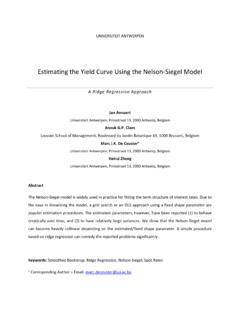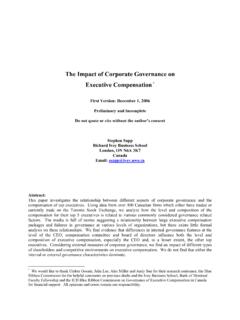Transcription of Estimating the Yield Curve Using the Nelson Siegel Model
1 UNIVERSITEIT ANTWERPEN Estimating the Yield Curve Using the Nelson Siegel Model A Ridge Regression Approach Jan Annaert Universiteit Antwerpen, Prinsstraat 13, 2000 Antwerp, Belgium Anouk Claes Louvain School of Management, Boulevard du Jardin Botanique 43, 1000 Brussels, Belgium Marc De Ceuster Universiteit Antwerpen, Prinsstraat 13, 2000 Antwerp, Belgium Hairui Zhang Universiteit Antwerpen, Prinsstraat 13, 2000 Antwerp, Belgium Abstract The Nelson Siegel Model is widely used in practice for fitting the term structure of interest rates. Due to the ease in linearizing the Model , a grid search or an OLS approach Using a fixed shape parameter are popular estimation procedures. The estimated parameters, however, have been reported (1) to behave erratically over time, and (2) to have relatively large variances.
2 We show that the Nelson Siegel Model can become heavily collinear depending on the estimated/fixed shape parameter. A simple procedure based on ridge regression can remedy the reported problems significantly. Keywords: Smoothed Bootstrap, Ridge Regression, Nelson Siegel , Spot Rates Corresponding Author Email: 1 1. Introduction Good estimates of the term structure of interest rates (also known as the spot rate Curve or the zero bond Yield Curve ) are of the utmost importance to investors and policy makers. One of the term structure estimation methods, initiated by Bliss and Fama (1987), is the smoothed bootstrap. Bliss and Fama (1987) bootstrap discrete spot rates from market data and then fit a smooth and continuous Curve to the data.
3 Although various Curve fitting spline methods have been introduced (quadratic and cubic splines (McCulloch (1971, 1975)), exponential splines (Vasicek and Fong (1982)), B splines (Shea (1984) and Steeley (1991)), quartic maximum smoothness splines (Adams and Van Deventer (1994)) and penalty function based splines (Fisher, Nychka and Zervos (1994), Waggoner (1997)), these methods have been criticized on the one hand for having undesirable economic properties and on the other hand for being black box models (Seber and Wild (2003)). Nelson and Siegel (1987) and Svensson (1994, 1996) therefore suggested parametric curves that are flexible enough to describe a whole family of observed term structure shapes.)
4 These models are parsimonious, they are consistent with a factor interpretation of the term structure (Litterman and Scheinkman (1991)) and they have both been widely used in academia and in practice. In addition to the level, slope and curvature factors present in the Nelson Siegel Model , the Svensson Model contains a second hump/trough factor which allows for an even broader and more complicated range of term structure shapes. In this paper, we restrict ourselves to the Nelson Siegel Model . The Svensson Model shares by definition all the reported problems of the Nelson Siegel approach. Since the source of the problems, collinearity, is the same for both models, the reported estimation problems of the Svensson Model may be reduced analogously.
5 The Nelson Siegel Model is extensively used by central banks and monetary policy makers (Bank of International Settlements (2005), European Central Bank (2008)). Fixed income portfolio managers use the Model to immunize their portfolios (Barrett, Gosnell and Heuson (1995) and Hodges and Parekh (2006)) and recently, the Nelson Siegel Model also regained popularity in academic research. Dullmann and Uhrig Homburg (2000) use the Nelson Siegel Model to describe the Yield curves of Deutsche Mark denominated bonds to calculate the risk structure of interest rates. Fabozzi, Martellini and Priaulet (2005) and Diebold and Li (2006) benchmarked Nelson Siegel forecasts against other models in term structure forecasts, and they found it performs well, especially for longer forecast horizons.
6 Martellini and Meyfredi (2007) use the Nelson Siegel approach to calibrate the Yield curves and estimate the value at risk for fixed income portfolios. Finally, the Nelson Siegel Model estimates are also used as an input for affine term structure models. Coroneo, Nyholm and Vidava Koleva (2008) test to which degree 2 the Nelson Siegel Model approximates an arbitrage free Model . They first estimate the Nelson Siegel Model and then use the estimates to construct interest rate term structures as an input for arbitrage free affine term structure models. They find that the parameters obtained from the Nelson Siegel Model are not statistically different from those obtained from the pure no arbitrage affine term structure models.
7 Notwithstanding its economic appeal, the Nelson Siegel Model is highly nonlinear which causes many users to report estimation problems. Nelson and Siegel (1987) transformed the nonlinear estimation problem into a simple linear problem, by fixing the shape parameter that causes the nonlinearity. In order to obtain parameter estimates, they computed the OLS estimates of a series of models conditional upon a grid of the fixed shape parameter. The estimates that, conditional upon a fixed shape parameter, maximized the R were chosen. We refer to their procedure as a grid search. Others have suggested to estimate the Nelson Siegel parameters simultaneously Using nonlinear optimization techniques. Cairns and Pritchard (2001), however, show that the estimates of the Nelson Siegel Model are very sensitive to the starting values used in the optimization.
8 Moreover, time series of the estimated coefficients have been documented to be very unstable (Barrett, Gosnell and Heuson (1995), Fabozzi, Martellini and Priaulet (2005), Diebold and Li (2006), Gurkaynak, Sack and Wright (2006), de Pooter (2007)) and even to generate negative long term rates, thereby clearly violating any economic intuition. Finally, the standard errors on the estimated coefficients, though seldom reported, are large. Although these estimation problems have been recognized before, it has never lead towards satisfactory solutions. Instead, it became common practice to fix the shape parameter over the whole time series of term Hurn, Lindsay and Pavlov (2005), however, point out that the Nelson Siegel Model is very sensitive to the choice of this shape parameter.
9 De Pooter (2007) confirms this finding and shows that with different fixed shape parameters, the remaining parameter estimates can take extreme values. Hence fixing the shape parameter is a non trivial issue. In this paper we use ridge regression to alleviate the observed problems substantially and to estimate the shape parameter freely. The remainder of this paper is organized as follows. In Section 2, we introduce the Nelson Siegel Model . Section 3 presents the estimation procedures used in the literature, illustrates the multicollinearity issue which is conditional on the estimated (or fixed) shape parameter and proposes an adjusted procedure based on the ridge regression. In the subsequent section (Section 4) we present our data and their 1 Barrett et al.
10 (1995) and Fabozzi et al. (2005) fix this shape parameter to 3 for annualized returns. Diebold and Li (2006) choose an annualized fixed shape parameter of to ensure stability of parameter estimation. 3 descriptive statistics. Since the ridge regression introduces a bias in order to avoid multicollinearity, we will mainly evaluate the merits of the models based on their ability to forecast the short and long end of the term structure. The estimation results and the robustness of our ridge regression are discussed in Section 5. Finally, we conclude. 2. A first look at the Nelson Siegel Model In their Model Nelson and Siegel (1987) specify the forward rate Curve f( ) as follows: ()()000/111/2221,/ffefef == ( ) where is time to maturity, 0, 1, 2 and are coefficients, with > 0.







